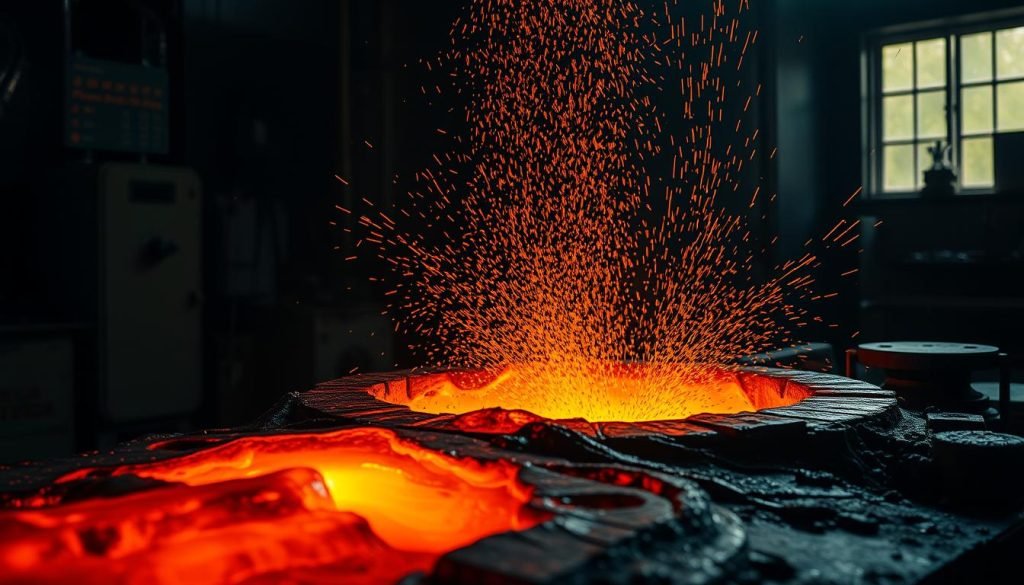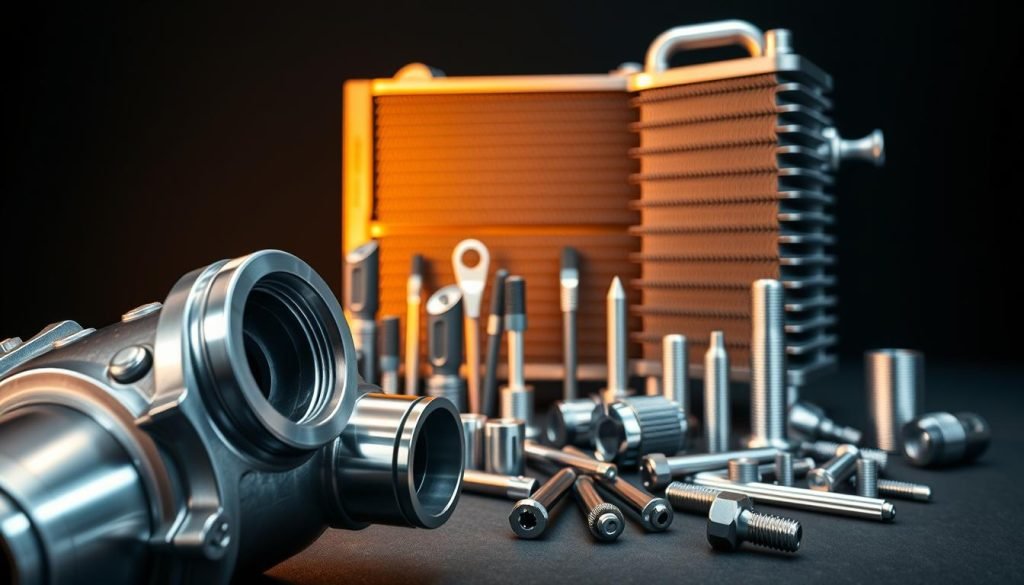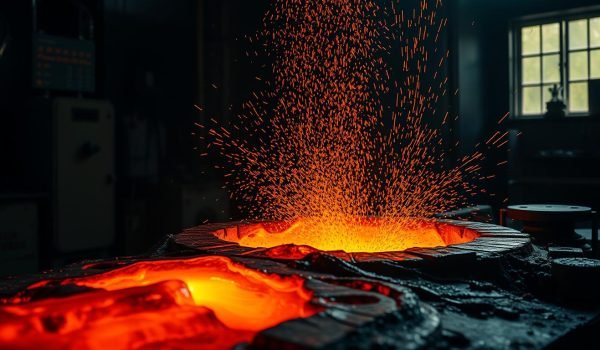Titanium is a remarkable metal known for its exceptional strength, low density, and resistance to corrosion. One of its most significant properties is its high melting point of 1668°C (3034°F), making it an ideal material for various high-temperature applications.

You’re about to explore the fascinating world of titanium and its high-temperature capabilities. This comprehensive guide will delve into the factors that contribute to titanium’s exceptional melting behavior and how this property influences its wide range of applications, from aerospace to medical implants.
Understanding Titanium: An Overview
You’re likely familiar with titanium’s applications, but understanding its fundamental characteristics is crucial. Titanium is a metal known for its high strength-to-weight ratio, corrosion resistance, and ability to withstand extreme temperatures. As you delve into the world of titanium, you’ll discover its unique properties make it an ideal material for various industries, from aerospace to medical devices.
Discovery and Naming of Titanium
Titanium was first discovered in 1791 by William Gregor, an English clergyman and amateur geologist. He identified the metal in ilmenite, a mineral found in Cornwall, England. The name “titanium” was later given to the element by Martin Heinrich Klaproth, a German chemist, who named it after the Titans of Greek mythology. This naming reflects the metal’s strong and enduring nature.
Physical Properties of Titanium
Titanium is known for its high strength, low density, and high corrosion resistance. It has a silver-gray appearance and is capable of withstanding extreme temperatures. The metal’s physical properties make it suitable for applications where high strength and low weight are critical, such as in aircraft and spacecraft components.
Chemical Properties of Titanium
Titanium’s exceptional resistance to corrosion stems from its ability to form a stable, continuous oxide film, primarily titanium dioxide, when exposed to oxygen. This protective layer provides a barrier against corrosive environments, making titanium invaluable for marine and chemical processing applications. You’re likely to find that titanium remains stable in most natural environments and can withstand exposure to seawater and dilute acids.
The Melting Point of Titanium: Key Facts
You need to know the melting point of titanium to appreciate its versatility in different industries. The melting point is a critical property that determines the suitability of titanium for various high-temperature applications.
Exact Melting Point Values
Titanium’s melting point is approximately 1,668°C (3,034°F). This value is crucial for understanding its behavior under high-temperature conditions. The precise melting point can vary slightly based on the purity and specific alloy of titanium being used.
Comparison with Other Metals
Compared to other metals, titanium has a relatively high melting point. For instance, aluminum melts at around 660°C (1,220°F), while steel melts between 1,370°C to 1,540°C (2,500°F to 2,800°F), depending on its composition. This high melting point makes titanium suitable for applications where other metals would fail.
Measuring Titanium’s Melting Point
Measuring titanium’s melting point requires sophisticated equipment due to its high temperature and reactivity. Techniques such as differential thermal analysis (DTA) and optical pyrometry are employed under controlled atmospheres to prevent contamination. These methods allow for accurate determination of the melting point by monitoring the temperature difference between titanium and a reference material or by analyzing the thermal radiation emitted during the phase transition.
The process of measuring the melting point involves heating the titanium sample in an inert atmosphere or vacuum to prevent reaction with atmospheric gases. High-temperature calorimetry is also used to provide additional data on the heat of fusion during the melting process.
The Science Behind Titanium’s High Melting Point
Understanding the science behind titanium’s high melting point requires a deep dive into its atomic and electronic configurations. You might be wondering what makes titanium so resistant to heat. The answer lies in its intricate atomic structure and the nature of its bonding.
Atomic Structure and Bonding
Titanium’s atomic structure plays a crucial role in its high melting point. The element’s electronic configuration is [Ar]3d²4s², which means it has partially filled d-orbitals. These d-orbitals allow for strong directional bonding between titanium atoms, significantly enhancing the material’s thermal stability. You can see that the presence of d-electrons in titanium’s atomic structure contributes to its high melting point by forming strong, localized bonds between metal atoms.
The d-orbital electrons participate in metallic bonding, creating stronger interatomic forces than those found in elements with only s-orbital valence electrons. This results in a robust crystal structure that requires substantial energy to disrupt, directly contributing to titanium’s high melting point.
Crystal Structure Influence
The crystal structure of titanium also influences its melting point. Titanium exhibits a hexagonal close-packed (hcp) crystal structure at room temperature, known as the alpha phase. This structure is characterized by a high degree of atomic packing efficiency, which contributes to the material’s strength and thermal stability. As you explore the properties of titanium, you’ll find that its crystal structure plays a significant role in its overall performance.
The hcp structure of titanium allows for strong bonding between atoms, making it more difficult for the material to melt. The arrangement of atoms in the crystal lattice is such that it maximizes the bonding between atoms, thereby increasing the melting point.
Electronic Configuration Effects
Titanium’s electronic configuration is a key factor in its high melting point. The delocalized electrons in titanium’s structure create an “electron sea” that binds the positively charged metal ions together. This electron sea requires significant thermal energy to disrupt, making it harder for the material to melt. You will notice that elements with similar electronic configurations, such as vanadium and zirconium, also exhibit relatively high melting points.
The participation of d-orbitals in bonding creates stronger cohesive forces throughout the metal’s crystalline structure. This is why titanium and other transition metals typically have higher melting points than main group elements. The unique electronic configuration of titanium is a critical aspect of its thermal resistance.
Factors Affecting Titanium’s Melting Point

Titanium’s melting behavior is complex and influenced by multiple factors, including purity, alloying elements, and environmental conditions. Understanding these factors is crucial for optimizing the melting process of titanium.
Purity Levels and Their Impact
The purity level of titanium significantly affects its melting point. Impurities can either lower or raise the melting point, depending on their nature. For instance, the presence of interstitial elements like oxygen and nitrogen can increase the melting point, while other impurities might have the opposite effect. Ensuring high purity levels is essential for precise control over the melting behavior.
Alloying Elements’ Influence
Alloying elements are added to titanium to enhance its properties, but they also impact its melting behavior. Different alloying elements can either increase or decrease the melting point. For example, aluminum and vanadium, commonly used in titanium alloys, can alter the melting characteristics. The specific effect depends on the type and amount of the alloying element.
Environmental Conditions
Environmental conditions, particularly the atmosphere in which titanium is heated, play a critical role in its melting behavior. The presence of reactive gases like oxygen can lead to the formation of oxides on the surface, affecting the melting process. To mitigate this, titanium is often melted in vacuum or inert gas environments, such as argon or helium, to prevent unwanted reactions.
You should also consider that pressure conditions can influence the melting point of titanium. Under high-pressure conditions, the melting point can increase according to thermodynamic principles. This factor is particularly relevant in high-pressure applications.
Different Forms of Titanium and Their Melting Points
You may encounter titanium in different forms, and their melting points can vary significantly. This variation is crucial for selecting the appropriate form of titanium for specific applications, especially those involving high temperatures.
Pure Titanium
Pure titanium has a melting point of approximately 1668°C (3034°F). This relatively high melting point makes it suitable for high-temperature applications. The purity of titanium affects its melting behavior, with higher purity generally resulting in a more consistent melting point.
Common Titanium Alloys
Titanium alloys, such as Ti-6Al-4V, have melting points that can differ from that of pure titanium. These alloys are designed to enhance certain properties, like strength and corrosion resistance, while their melting points may be slightly altered. For instance, the melting range of Ti-6Al-4V is generally between 1604°C to 1660°C (2920°F to 3020°F).
Titanium Compounds
Titanium compounds, including titanium dioxide (TiO2), titanium carbide (TiC), and titanium nitride (TiN), exhibit a wide range of melting points. TiO2 melts at approximately 1843°C (3349°F), while TiC has an even higher melting point of about 3160°C (5720°F). In contrast, titanium tetrachloride (TiCl4) is a liquid at room temperature, with a melting point of -24°C (-11°F). These variations are due to the different types of chemical bonding in these compounds.
Titanium Alloys: Composition and Melting Behavior
When you explore titanium alloys, you’ll discover that their composition significantly influences their melting behavior. Titanium alloys are engineered by combining titanium with other elements to achieve specific properties, including melting characteristics.
Ti-6Al-4V: The Most Common Alloy
Ti-6Al-4V is one of the most widely used titanium alloys, known for its high strength, low density, and excellent corrosion resistance. This alloy contains 6% aluminum and 4% vanadium, with the balance being titanium. The addition of aluminum and vanadium alters the melting behavior of pure titanium, creating a melting range rather than a single melting point.
The melting range of Ti-6Al-4V is typically between 1604°C to 1660°C, which is slightly lower than that of pure titanium. This reduction in melting temperature is primarily due to the presence of vanadium, a beta-stabilizing element that tends to lower the melting point.
Other Important Titanium Alloys
Beyond Ti-6Al-4V, there are numerous other titanium alloys, each with its unique composition and melting characteristics. For instance, alloys like Ti-5Al-5V-5Mo-3Cr and Ti-10V-2Fe-3Al contain additional elements that further modify their melting behavior.
These alloys are designed for specific applications, where their melting properties play a crucial role in processing and performance. For example, in aerospace applications, the ability to control the melting and solidification process is critical for achieving the desired microstructure and mechanical properties.
How Alloying Changes Melting Properties
Alloying elements can significantly alter the melting properties of titanium by creating multi-component systems. Beta-stabilizing elements like vanadium and molybdenum generally lower the melting temperature, while alpha-stabilizing elements can have more complex effects.
Understanding these effects allows metallurgists to design alloys with specific melting characteristics, optimized for various manufacturing processes. Whether it’s investment casting, additive manufacturing, or conventional wrought processing, the melting behavior of titanium alloys is a critical factor in determining their suitability for different applications.
Phase Transformations in Titanium
Understanding phase transformations in titanium is essential for optimizing its use in various applications. Titanium, a versatile metal known for its high strength-to-weight ratio and corrosion resistance, undergoes significant changes as it is heated or cooled.
Alpha and Beta Phases
Titanium exists in two primary crystal structures: alpha (α) and beta (β). At room temperature, titanium is in its alpha phase, which has a hexagonal close-packed (hcp) crystal structure. As the temperature increases to approximately 882°C (1,620°F), titanium transforms into its beta phase, characterized by a body-centered cubic (bcc) structure. This transformation is crucial because the beta phase has different properties, such as improved ductility, which facilitates shaping and forming processes.
You’ll find that the specific heat capacity of titanium changes dramatically near this transition temperature. As titanium approaches the alpha-to-beta transformation, its specific heat increases sharply, then decreases and stabilizes in the beta phase region. This change is significant for processing, as it affects how titanium is heated and shaped.
Phase Transition Temperatures
The temperature at which titanium transforms from alpha to beta is a critical parameter in its processing. This phase transition temperature defines the boundary between different processing regimes and determines the microstructural evolution during heating and cooling cycles. For pure titanium, this transition occurs at 882°C (1,620°F), well below its melting point of 1,668°C (3,034°F). The gap between the phase transition and melting point creates a processing window that allows for hot working operations like forging, where the metal’s improved ductility in the beta phase facilitates shaping while avoiding melting.
In titanium alloys, the phase transition temperatures can vary significantly based on composition. Some beta alloys maintain a stable beta structure at room temperature, while alpha+beta alloys exhibit complex transformation behavior across a range of temperatures. Understanding these transitions is vital for optimizing the properties of titanium alloys for specific applications.
Methods for Melting Titanium
Titanium’s high melting point and chemical reactivity make its melting a challenging task that demands specific methods. You need to consider several factors when melting titanium, including its reactivity with atmospheric gases and the need for specialized containment systems.
Electric Arc Furnaces
Electric arc furnaces are one of the methods used for melting titanium. This process involves creating an electric arc between electrodes, which generates the high temperatures needed to melt titanium. The furnace is typically operated in a vacuum or inert atmosphere to prevent contamination and reaction with oxygen.
Induction Melting
Induction melting is another technique used for titanium. This method involves using electromagnetic induction to heat the metal. It’s a relatively quick process and can be performed in a controlled atmosphere, reducing the risk of contamination. However, it requires careful control of the induction coil and crucible material to prevent reaction with the molten titanium.
Challenges in Melting Titanium
Melting titanium presents several challenges, including its high reactivity with atmospheric gases like oxygen, nitrogen, and hydrogen. These reactions can severely compromise the mechanical properties of the final product. Additionally, controlling the solidification process is difficult due to titanium’s poor thermal conductivity and high heat of fusion, which can lead to issues like porosity and segregation.
Titanium’s High-Temperature Behavior
Understanding how titanium reacts to heat is essential for leveraging its strengths in different industries. As you explore the properties of titanium at elevated temperatures, you’ll discover its unique characteristics and potential applications.
Thermal Expansion Properties
Titanium’s thermal expansion properties are crucial for its high-temperature applications. As temperature increases, titanium expands, and this expansion must be considered in design and engineering. The coefficient of thermal expansion for titanium is relatively low compared to other metals, making it suitable for applications where dimensional stability is critical.
Heat Capacity and Thermal Conductivity
Titanium has a moderate heat capacity and relatively low thermal conductivity. This means it can absorb and release heat, but it doesn’t conduct heat as efficiently as some other metals. These properties influence how titanium is used in heat exchangers, engines, and other high-temperature equipment.
Oxidation Behavior at High Temperatures
Titanium readily reacts with oxygen at high temperatures, forming titanium dioxide. You’ll find that above approximately 600°C (1112°F), titanium’s oxidation accelerates, and at temperatures above 1000°C (1832°F), it can lead to rapid oxidation and potential combustion. To mitigate this, specialized coatings or controlled atmospheres are often used.
For high-temperature applications, titanium often requires protective measures to prevent excessive oxidation. Specialized high-temperature titanium alloys incorporating elements like aluminum and silicon form more stable protective oxides, enhancing their performance in extreme environments.
Aerospace Applications of Titanium’s Heat Resistance
Aerospace innovations often leverage titanium’s unique properties, particularly its heat resistance, to push the boundaries of flight technology. You can see this in various applications where titanium’s high strength-to-weight ratio and ability to withstand extreme temperatures are crucial.
Aircraft Engine Components
Titanium is widely used in aircraft engine components due to its ability to maintain structural integrity at high temperatures. This property is essential for components like compressor blades and discs, where high strength and low weight are critical. The use of titanium in these applications contributes to more efficient engine performance and reduced fuel consumption.
Spacecraft and Rocket Parts
In spacecraft and rocket applications, titanium’s heat resistance is vital for withstanding the extreme temperatures encountered during launch and re-entry. Components such as rocket nozzles and heat shields benefit from titanium’s ability to maintain its properties under intense thermal stress. This ensures the reliability and safety of spacecraft and rockets.
Future Aerospace Innovations
Future aerospace innovations are expected to further exploit titanium’s properties through advanced manufacturing techniques like additive manufacturing. This allows for the creation of complex geometries that optimize thermal management and structural efficiency. Additionally, research into titanium aluminide (TiAl) intermetallic compounds and titanium matrix composites (TMCs) is advancing rapidly, promising even more capable materials for next-generation aerospace applications.
Medical Applications Leveraging Titanium’s Properties
You can leverage titanium’s exceptional characteristics in medical fields for superior performance. Titanium’s high melting point and corrosion resistance make it an ideal material for medical instruments that require repeated sterilization at high temperatures.
Surgical Instruments and Implants
Titanium’s exceptional resistance to high-temperature sterilization methods represents a significant advantage in medical applications. This allows instruments to withstand thousands of autoclave cycles without degradation. The metal maintains its dimensional stability and mechanical properties through repeated thermal cycling during sterilization, ensuring consistent performance and precision throughout their service life.
Sterilization Advantages
The advantages of using titanium in medical applications extend to its ability to withstand both high-temperature steam sterilization and aggressive chemical disinfectants without surface degradation. This contributes to longer instrument life cycles, reducing replacement costs and improving the sustainability of medical practices. Standard autoclave sterilization exposes instruments to temperatures of 121-134°C (250-273°F) under pressure, conditions that titanium easily withstands due to its melting point of 1668°C (3034°F) and excellent oxidation resistance.
Titanium’s corrosion resistance to sterilizing chemicals like glutaraldehyde, hydrogen peroxide, and peracetic acid provides additional versatility in sterilization options. This is particularly beneficial for heat-sensitive components that may be attached to titanium frameworks.
Industrial Uses Based on Titanium’s Melting Point
You can find titanium being utilized in multiple industries due to its high melting point and corrosion resistance. This versatile metal plays a crucial role in various industrial applications, from chemical processing equipment to marine engineering and energy sector utilization.

Chemical Processing Equipment
Titanium is widely used in chemical processing due to its ability to withstand corrosive environments. Its high melting point ensures that it remains durable even in extreme temperatures. You can find titanium components in reactors, heat exchangers, and other equipment where corrosion resistance is critical.
Marine Engineering Applications
In marine engineering, titanium’s corrosion resistance is particularly valuable. It is used in seawater-cooled heat exchangers, condensers, and other components exposed to harsh marine environments. The durability of titanium reduces maintenance needs and extends the lifespan of equipment.
Energy Sector Utilization
The energy sector increasingly relies on titanium in power generation facilities, particularly in heat exchangers and condensers for both fossil fuel and nuclear power plants. Titanium’s corrosion resistance and heat transfer properties provide superior performance. Additionally, its use in geothermal energy systems, liquefied natural gas (LNG) processing, and offshore wind turbines further demonstrates its versatility in the energy sector.
Titanium’s role in the emerging hydrogen economy is also significant, with applications in electrolyzers and fuel cells where its corrosion resistance is crucial.
Automotive and Consumer Applications
You can find titanium being utilized in a range of applications, from high-performance vehicles to everyday consumer goods. Its unique combination of strength, low density, and corrosion resistance makes it an attractive material for various industries.
High-Performance Vehicle Components
Titanium is widely used in the automotive sector, particularly in high-performance vehicle parts. Its high strength-to-weight ratio allows for the creation of lighter components, which can significantly improve a vehicle’s power-to-weight ratio and overall performance. Engine parts, such as connecting rods and valves, benefit from titanium’s strength and low density. Additionally, suspension components made from titanium can enhance handling and reduce unsprung weight.
Consumer Products Using Titanium
Consumer products increasingly feature titanium for its unique properties. Sporting goods, such as golf club heads and bicycle frames, benefit from titanium’s exceptional strength-to-weight ratio and vibration damping characteristics. You’ll also find titanium used in premium eyewear frames, high-end watches, and jewelry, where its hypoallergenic properties and durability are valued. Moreover, cookware and cutlery made from titanium offer non-reactive surfaces and lightweight construction, improving handling comfort. The use of titanium in these applications demonstrates its versatility and the value it brings to various consumer products.
Challenges in Working with High-Melting-Point Titanium
The processing of titanium is complicated by its exceptionally high melting point. You encounter several challenges when working with this metal, from machining difficulties to cost implications.
Machining Difficulties
Machining titanium is notoriously challenging due to its high melting point and reactivity. The material’s poor machinability results in longer processing times, higher tool consumption, and greater scrap rates compared to conventional metals. Specialized tooling and techniques are required to efficiently machine titanium components.
Welding Considerations
Welding titanium requires careful consideration due to its reactivity at high temperatures. To prevent contamination and ensure strong welds, specialized equipment and controlled environments are necessary. Techniques such as inert gas shielding are commonly used to protect the metal during the welding process.
Cost Implications
The production cost of titanium is significantly higher than many other metals due to its complex extraction and processing methods. The energy-intensive Kroll process, multiple steps involved, and the need for specialized equipment all contribute to the elevated costs. Despite these challenges, titanium’s unique properties often justify its use in critical applications where its benefits outweigh the additional expense.
You should consider the lifecycle economics of titanium, which often prove favorable in applications where its unique properties enable longer service life, reduced maintenance, lighter weight, or operation in environments where alternative materials would fail prematurely.
Future Trends in Titanium Processing and Applications
As you explore the future of titanium, you’ll discover new processing techniques and applications that are revolutionizing industries. Titanium continues to find new applications in high-temperature environments due to its unique combination of properties.
Emerging Manufacturing Techniques
Advanced manufacturing techniques are transforming the production of titanium components. You’ll see significant advancements in the use of titanium matrix composites (TMCs) and advanced titanium alloys, particularly in the aerospace industry. These materials are capable of withstanding extreme temperatures generated at speeds exceeding Mach 5, making them ideal for hypersonic aircraft and spacecraft.
Furthermore, the development of advanced surface treatments and coatings is extending titanium’s temperature capabilities. Thermal barrier coatings and oxidation-resistant surface modifications are enabling the use of titanium in environments that would otherwise exceed its operational limits.
New High-Temperature Applications
The unique properties of titanium make it suitable for various high-temperature applications. You’ll find titanium increasingly considered for concentrated solar power applications, where its corrosion resistance and thermal properties are beneficial for high-temperature heat transfer systems and thermal energy storage components.
The growing hydrogen economy also presents new opportunities for titanium. It is particularly useful in solid oxide electrolysis cells and high-temperature fuel cells operating at 600-800°C, where titanium components offer both corrosion resistance and thermal stability. Advanced titanium aluminide (TiAl) intermetallic compounds are expanding the temperature capabilities of titanium-based materials, with potential applications in gas turbine low-pressure turbine blades.
Conclusion: The Significance of Titanium’s Melting Properties
The unique combination of titanium’s melting point and other properties drives innovation in multiple fields. You’ve seen how its exceptional melting point of 1668°C enables applications across industries where high-temperature performance is critical. Factors such as purity, alloying elements, and processing conditions influence titanium’s melting behavior, allowing engineers to fine-tune its properties. As manufacturing technologies evolve, titanium’s melting properties will remain crucial in material selection and processing, ensuring its continued role in advancing technology.




